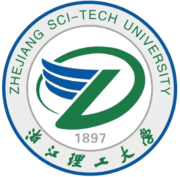Zhejiang Sci-Tech University
| 浙江理工大学 | |
 | |
Former names |
Sericultural Academy Zhejiang Institute of Science and Technology Zhejiang Institute of Silk Textile |
|---|---|
| Type | Public |
| Established | 1897 |
| President | Chen wenxing (陈文兴) |
Academic staff | 1,800 |
| Students | 26,000 |
| Location |
Hangzhou, Zhejiang, |
| Campus | Xiasha, Wenyi |
| Website | www.zist.edu.cn (English) |
Zhejiang Sci-Tech University (ZSTU; simplified Chinese: 浙江理工大学; traditional Chinese: 浙江理工大學; pinyin: Zhèjiāng lǐgōng dàxué) is a university in Zhejiang province that provides programs in the fields of engineering, sciences, humanities (arts), economics, management and law with engineering being its main focus. It is run jointly by Ministry of Education and the Zhejiang provincial government, the latter being the main administrative body.
Campus
ZSTU is in Hangzhou and has two campuses, covering a total area of 1,500 mu.
History
The history of ZSTU dates back to the Sericultural Academy, which was founded in 1897 and was one of the earliest modern educational institutions in China. The school began to enroll undergraduate students in 1959 and graduate students in 1979. It acquired the right to confer master's degrees in 1983 and was granted the right by Ministry of Education to appraise the qualifications of teachers applying for the title of associate professor in 1993.
In 1995, it started to offer PhD programs in collaboration with Zhejiang University. The same year saw the first international enrollments and the enrollment of students from Hong Kong, Macao and Taiwan. In 1999, it began to confer master's degrees to on-the-job students who are of the equivalent education level. In 2001, it was granted the right to confer master's degrees to engineering students. In 2003 it was approved as an institution qualified to provide joint PhD programs and in 2006 it got the right to confer Doctoral degree.
ZSTU now has graduate programs, undergraduate programs and adult education, the latter in the form of public education, non-governmental education and education through international cooperation.
In April 1999 the institution changed its name from Zhejiang Institute of Silk Textile to Zhejiang Institute of Science and Technology. In May 2004, ZIST was renamed to Zhejiang Sci-Tech University.
Administration
Schools and departments
ZSTU consists of 16 schools or faculties (departments):
- the school of sciences
- the schools or faculties of materials and textiles
- apparel
- informatics and electronics
- mechanical and automation control
- construction engineering
- life sciences
- art and design
- economics and management
- law and politics
- foreign languages
- culture and communications
- adult education
- higher vocational college
- department of computer teaching
- department of physical education
It owns one independent college on another campus. Two of its disciplines are regarded by the province as very important, and eight are key disciplines at provincial or ministerial level. It has one key laboratory of the Ministry of Education and two key laboratories of the Zhejiang Province. The school offers 45 undergraduate programs, of which six are provincial key programs.
It confers Doctoral degree in two disciplines, Master’s degrees in four first-level disciplines and 30 second-level disciplines (sub-disciplines), and it provides one joint Doctoral program and two Master’s programs in engineering.
The school has two pilot centers for teaching basic courses in Zhejiang Province, two provincial engineering centers, six R&D centers and more than 40 school labs and institutes of excellence.
Students
At present, the number of full-time undergraduate and graduate students enrolled at ZSTU is 18,000; an additional 2000 students are in programs of adult education and further education.
Library
In recent years, the school’s required enrollment score has been among the highest of the HELs in Zhejiang province - as has been the employment rate of its students.
Awards
ZSTU has won over 120 research awards, among which three are national — two second awards of the National Scientific and Technological Invention Award and one second award of the National Scientific and Technological Progress Award — and over 20 are provincial or ministerial.
It has research funds of more than 110 million yuan.
External links
| Wikimedia Commons has media related to Zhejiang Sci-Tech University. |
- Zhejiang Sci-Tech University (English)